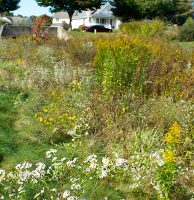
Project Spotlights: Riparian Buffer Designs
LandStudies’ approach to landscape design uses a customized process that includes site assessment, feasibility, and value analysis to provide consistent, creative, and cost-effective solutions. Our landscape architects and support team are creative design professionals who understand natural system succession and have learned to balance aesthetics and functionality to create self-sustaining environments. Our designs incorporate the use of native plants, invasive plant control, and implementation techniques tailored to a project’s requirements.
The design process is scalable at all levels, including anywhere from an individual site to a regional approach for municipalities or watersheds. Our design expertise includes, but is not limited to: the creation of native meadows and riparian and hedgerow buffers; delineation and restoration of wetlands and ponds; reforestation of forest canopy understories; restoration of streams and floodplains; and integration of native plant communities into the built environment through stormwater best management practices (BMPs), groundwater recharge, bio-swales, and other practices.
The following project summaries demonstrate two riparian buffer design projects that LandStudies is excited to be part of.
Lancaster City – Buffering the Conestoga
LandStudies is working with the City of Lancaster, Lancaster Township, East Lampeter Township and the Lancaster County Conservancy on the “Buffering the Conestoga” pilot program with the assistance of funding provided by DCNR. The ultimate goal of this program is to plant a total of 10 acres of multifunctional riparian buffers for improving water quality in the Conestoga River Watershed. Services include site selection, planting designs, plant procurement and public education. This program will provide guidance on planting and maintaining multifunctional riparian buffers to conservation organizations, property owners, and residents.
As part of this project, LandStudies is also developing a user-friendly Design Guide for site preparation, installation and maintenance of riparian forest buffers. LandStudies experienced staff will also be helping to facilitate maintenance training workshops intended to build capacity in the community for long-term sustainability of the plantings.
The Design Guide will provide the following information for a wide demographic of users:
- What are multifunctional buffers?
- A Step-by-Step guide to implementing a riparian buffer
- Easily understood and replicable riparian buffer designs and maintenance procedures
- Native plant recommendations
- Short and long-term maintenance procedures
The project partners are working together to coordinate these plantings, with additional technical assistance and volunteer training from The Lower Susquehanna Initiative of Penn State’s Agriculture and Environment Center.
Penn State Harrisburg – Campus Beautification
LandStudies is providing design services for the entrance corridor on Penn State Harrisburg’s campus as part of a campus beautification project. The final planting strategies and associated strategy guide will include information on site preparation and installation information; species recommendations; maintenance guidelines; unit cost opinion; and potential phasing which are intended to be used as a framework for future plantings that will be installed by campus staff.
The design includes strategies for native plant communities that provide aesthetic and water quality improvement, along with increase bio-diversity. The design considers the restoration of the stream and riparian corridor, upland meadows, bio-retention and native plant strategies for entrance features.


